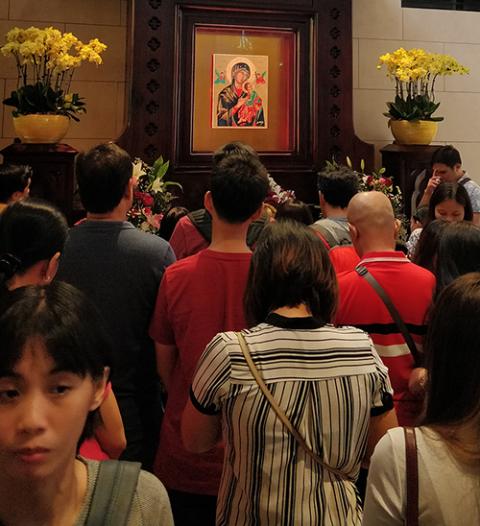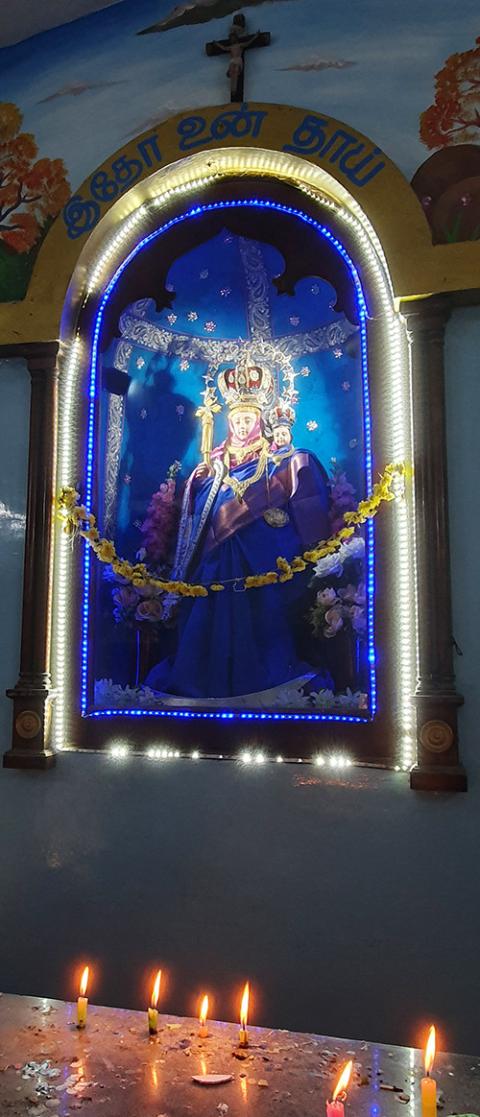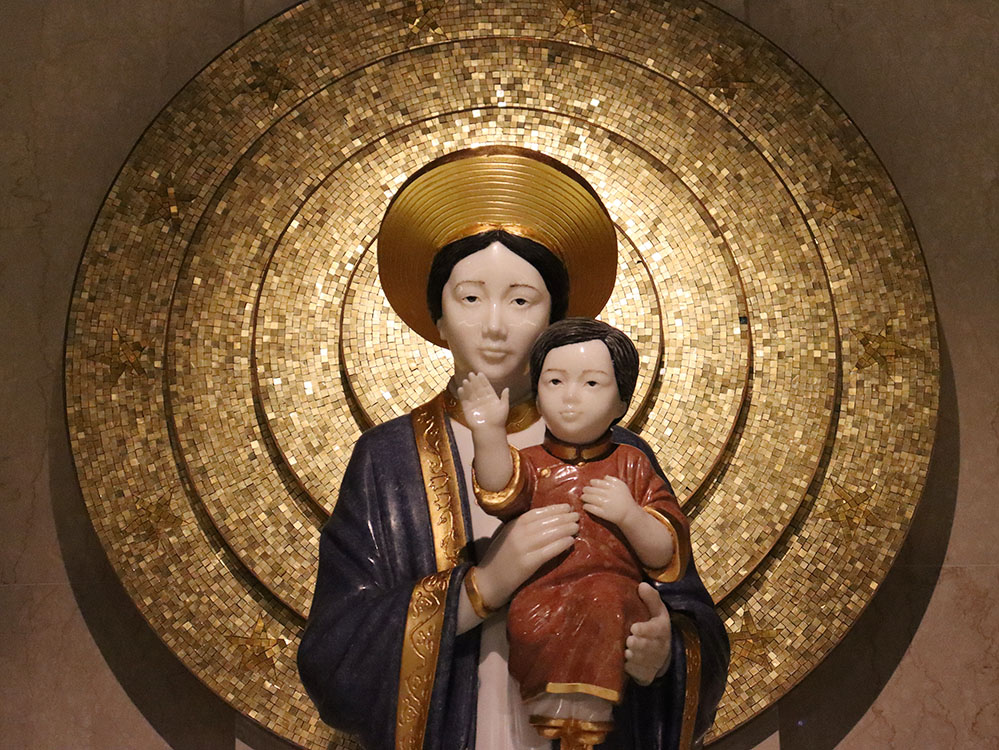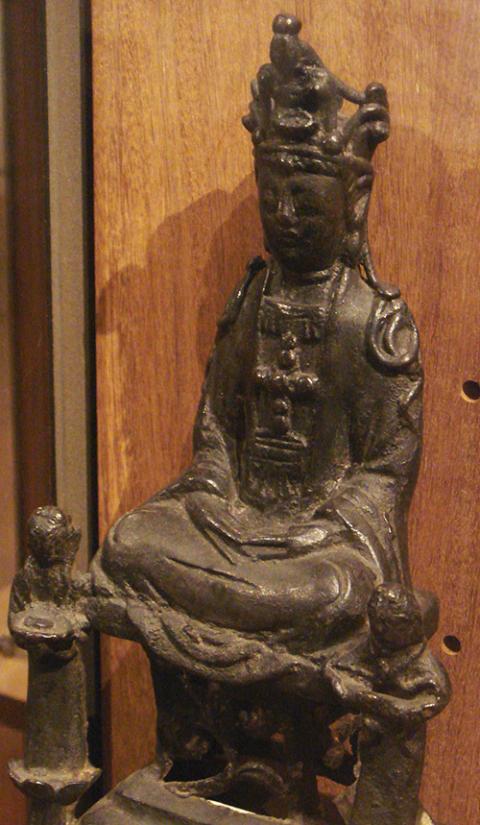
Statues of Our Lady of Velankanni predominate in a display of religious items in Chennai, India. (Dreamstime/Yahodkumar05)
Most people know that the Virgin Mary is very popular among Catholic and Orthodox Christians. But what they usually don't know is that the Mother of God is also venerated by devotees from other faiths such as Islam, Buddhism and Hinduism. She might not be necessarily part of the official teaching of these traditions but she still attracts devotees. As new research shows, Mary is the most universal religious figure of our contemporary world.
Although this panreligious nature of Marian devotions may raise concerns about syncretism, there is a lot to learn from it. The universality of Mary helps us to revisit the ways we understand religion, interreligious relations and religious regulations, especially in Asia.

People pray at Novena Church, a shrine under the care of the Redemptorists in Singapore. (Wikimedia Commons/Exec8)
For instance, in the wealthy city-state of Singapore, Christians are not the only ones who pray to Mary. At the most famous church of the island-state, a Marian shrine under the care of the Redemptorists, it is not uncommon to see Muslim and Hindu devotees bringing their petitions to Mary.
Some explain that when they were young, they went to a Catholic school and got in the habit of making vows to the Virgin. They pray according to their own religious tradition but keep Mary in their own spiritual life.
Sometimes Mary is also integrated into the pantheon of non-Christian movements. The Origin of the Self, for instance, is a new religious movement attracting thousands of disciples in Singapore, Malaysia, Taiwan, Hong Kong, Canada, etc. According to the founder, all humans have the capacity to achieve a higher state of being through mental meditation, offerings and virtuous actions.
In this Taoist-based religious movement, Mary appears as the one who meditated things in her heart, gave birth to a higher being and did not die like us. Like Siddhartha Gautama (the Buddha) and the Taoist Laozi (LaoTzu), Mary revealed the spiritual potential of humankind and she illustrates how Christianity does not contradict the teaching of the Origin of the Self.

An altar at the headquarters of the Origin of the Self in Singapore represents the many deities venerated by the movement, including Jesus, Mary and St. Joseph, as seen upper right. (Michel Chambon)
In South Korea, some Buddhist devotees perceive Mary as the emanation of the bodhisattva Guanyin, a feminine deity of compassion. In some households eager to maintain religious harmony, statues of Mary and of Guanyin stand together and receive the same incense.
In premodern Japan, persecuted Christians even produced representations of Mary with the appearance of Guanyin. Theories suggest that the female and motherly features of this bodhisattva may have been indeed inspired by the Christian figure of Mary.
In Central and East Asia, the encounter between Buddhism and Christianity has a very long history. And often, it has been mediated through Marian devotions.

A small chapel built by poor fishermen on a beach on the coast of Chennai, India, honors Our Lady of Velankanni. (Michel Chambon)
Another example of these panreligious circulations of Mary comes from South Asia. In India, numerous Hindu devotees go to Our Lady of Velankanni, where Mary is said to have appeared in the 16th and 17th centuries, to pray and make vows. Concerned with health, family or work issues, they join Catholic pilgrims to seek help from Mary.
Their way to approach Mary is highly similar to how they revere Hindu deities. They make vows, promise material offerings and specific actions, and hope for progress in their life. Ultimately, Hindu devotees look after Mary's capacity to improve things.
This panreligious nature of Marian devotions can challenge our understanding of religion. Modern people believe that religions are coherent bodies of doctrines defined by a set of scriptures and a specific clergy. But with the venerations of Mary by Hindu, Buddhist or Taoist devotees, this supposedly universal definition of religion does not really work. Religious practices do not always fit into predefined doctrines. People draw inspiration from different sources.
To make sense of this panreligious presence of Mary, some claim that Marian devotions reflect primordial impulses linked to fertility and motherhood. In their eyes, Marian devotions simply illustrate how Oedipal attachments continue to shape our unconscious religious life.
But scholars' research suggests that this psychologizing approach is rather superficial, condescending and distant from the richness of popular piety.
For the Singapore-based Origin of the Self, the sexual identity of Mary does not really matter. What matters is that Mary meditated and reached a new state of being — not that she was a woman. Similarly, Hindu devotees revere Mary because she belongs to the higher world of the deities who can transform things. Before being a mother, she is a deity — in a Hindu way of defining deities.
Advertisement
Even within Catholicism, motherhood is not necessarily enough to understand the aura of Mary. In Vietnam, Catholic devotions to Our Lady of La Vang — a Marian apparition of the late 18th century — show that the Mother of God is more than fertility.
Until the end of the 20th century, Our Lady of La Vang was represented through artistic features rooted in a European style. But in the late 1990s, Vietnamese bishops got inspired by Van Nhan Tran, a U.S.-based Vietnamese artist, and began to promote representations of Our Lady of La Vang wearing traditional Vietnamese outfits such as white traditional clothes (áo dài) and a golden headdress.
Today, this Vietnamese version of Mary has become extremely popular, in Vietnam and beyond. For some, she is a matter of national pride, for others a symbol of the harmonious diversity that Catholicism supposedly represents. Her worldwide popularity unfolds a complex translation of Marian devotions rooted in different political contexts, migratory patterns and international imaginaries. Her recent Vietnamese ethnicization through transnational relations show how Marian devotions are rich and multifaceted realities.

The Chapel of Our Lady of La Vang in the Basilica of the National Shrine of the Immaculate Conception, Washington, D.C. (NCR photo/Teresa Malcolm)
For Catholics, Hindus and Taoists, Mary cannot be reduced to her gender. The universality of Marian devotions is not the unconscious return of fertility cults. The many ways people approach Mary reflect the intricate diversity and complexity of the children of God.
Worshippers and devotees are not easily reducible to their predefined religions. They assert their own hopes and needs that are often shaped by religious languages, sociopolitical realities and cultural habits.
This cross-religious presence of Mary invites us to also reconsider interreligious relations. In Singapore, India and Vietnam, some political parties have long promoted an understanding of religions in which the risk for intercommunal violence is always highlighted.
In their eyes, religions make people highly emotional and irrational. Therefore, in highly diverse societies, the state must closely monitor religions and religious leaders to prevent interreligious violence. This characterization of religions is a way to reinforce the legitimacy of the state and its control over people.

A 17th-century Japanese statue of Mary incorporates imagery of the bodhisattva Guanyin, a feminine deity of compassion in Buddhism. (Wikimedia Commons/PHGCOM)
But panreligious Marian devotions provide a different understanding of interreligious relations. First, we saw that religions cannot be reduced to predefined and mutually exclusive systems. Lived religions are more creative, mixed and flexible.
Second, Mary shows that faith practitioners are able to ignore established authorities and official doctrines to cross boundaries without killing each other. Pious people can generate a wide range of cross-religious devotions and pilgrimages to build unity in diversity.
Despite concerns for narrowly defined orthodoxy, Mary stands as an interreligious bridge who belongs to everyone. She is a popular ally to build religious coexistence and prevent intercommunal violence. In practice, she offers an alternative to vertical control and condescendence.
With this in mind, the Center for Marian Studies in the U.K. and the Initiative for the Study of Asian Catholics in Singapore are organizing an online research conference May 10-12 on "More Universal Than Catholicism?: Mary Among Asian Religions" to explore in a more systematic way the panreligious circulations of Mary.
Since Marian devotions are not easily reducible to premade explanations, they deserve more than intellectual disdain and doctrinal reinforcement. If they challenge various ideologies and doctrines, they also remind us that devotional practices are well alive and can address all sorts of hopes, concerns and needs.





